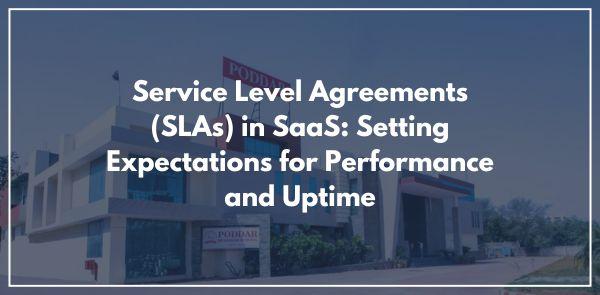
Introduction
In the competitive world of Software as a Service (SaaS), delivering a seamless and reliable customer experience is essential. To ensure mutual understanding and accountability between SaaS providers and their clients, Service Level Agreements (SLAs) are a critical component of the business relationship.
An SLA is a legally binding contract that outlines the expected levels of service, such as system uptime, performance, and response times. It sets clear benchmarks, defines responsibilities, and provides remedies if the agreed-upon service levels are not met. This article explores the essentials of SLAs in SaaS, their key components, and their importance in fostering trust and transparency.
What Is a Service Level Agreement (SLA)?
A Service Level Agreement (SLA) is a contractual document between a SaaS provider and its customers that defines:
- The scope of services offered.
- Performance metrics the provider is obligated to meet.
- Remedies or penalties in case of service failures.
SLAs are particularly critical in the SaaS industry because customers rely heavily on cloud-based software for their daily operations. Any disruption or subpar performance can lead to operational losses, making it essential for providers to clearly articulate their commitments.
Key Components of an SLA in SaaS
1. Uptime Guarantees
One of the most critical metrics in a SaaS SLA is uptime, often expressed as a percentage (e.g., 99.9%). This defines how consistently the software will be available to customers.
- Typical Uptime Levels:
- 99.9% uptime: Approx. 8.76 hours of downtime per year.
- 99.99% uptime: Approx. 52.56 minutes of downtime per year.
- Importance: High uptime guarantees are critical for mission-critical applications used by enterprise clients.
2. Performance Metrics
SLAs should define measurable performance indicators, such as:
- Response Times: Time taken to process user requests.
- Latency: Time taken for data to travel between servers and end-users.
- Scalability: Ability of the software to handle increased usage without performance degradation.
3. Support and Response Times
The SLA should specify how quickly the provider will respond to customer support requests.
- Categories: Critical issues, high-priority issues, and minor issues.
- Example:
- Critical issue: Response time within 1 hour, resolution within 4 hours.
- Minor issue: Response time within 24 hours, resolution within 3 business days.
4. Data Security and Compliance
Given the importance of data privacy in SaaS, SLAs must include provisions for:
- Compliance with regulations like GDPR, CCPA, and India’s IT Act, 2000.
- Backup and disaster recovery protocols to ensure data integrity in case of system failures.
5. Penalties for Service Failures
To ensure accountability, SLAs often include penalties if the provider fails to meet agreed service levels.
- Service Credits: Refunds or credits applied to future invoices if performance falls short.
- Termination Rights: Option for the customer to terminate the contract if repeated failures occur.
6. Exclusions and Limitations
SLAs should clearly define circumstances that exempt the provider from liability, such as:
- Downtime due to scheduled maintenance.
- Issues caused by third-party integrations or customer errors.
- Force majeure events, such as natural disasters.
7. Monitoring and Reporting
To maintain transparency, SLAs should include provisions for regular performance monitoring and reporting.
- Providers may offer real-time dashboards or periodic reports to track uptime, usage, and system health.
Why Are SLAs Important for SaaS Businesses?
1. Building Customer Trust
SLAs provide customers with the confidence that their service provider is committed to delivering high-quality performance.
2. Setting Clear Expectations
By defining measurable metrics and responsibilities, SLAs reduce misunderstandings and align expectations between both parties.
3. Risk Management
SLAs mitigate legal and reputational risks by ensuring both parties agree on remedies for service failures.
4. Competitive Advantage
For SaaS providers, offering robust SLAs can differentiate them from competitors and attract enterprise clients who require higher service guarantees.
Challenges in Drafting SLAs for SaaS
While SLAs are essential, drafting and implementing them comes with challenges:
- Balancing Commitments: Providers must strike a balance between ambitious service guarantees and realistic capabilities.
- Global Compliance: SaaS providers operating internationally must comply with varied legal frameworks and data protection laws.
- Customization: Enterprise clients often demand tailored SLAs, requiring additional legal and operational efforts.
Best Practices for SaaS Providers
- Be Transparent: Clearly define metrics, exclusions, and remedies to avoid disputes.
- Invest in Monitoring Tools: Use tools to track performance metrics and provide real-time reports to customers.
- Collaborate with Legal Experts: Ensure SLA terms comply with local and international laws.
- Regularly Update SLAs: Revise agreements as business needs, technologies, or regulatory landscapes evolve.
- Communicate Maintenance Schedules: Inform clients in advance about planned downtimes to minimize disruptions.
Conclusion
Service Level Agreements (SLAs) are the backbone of trust in the SaaS industry. By defining uptime, performance metrics, and remedies for failures, SLAs help SaaS providers demonstrate accountability and maintain strong customer relationships.
For tech entrepreneurs, crafting robust and transparent SLAs not only ensures compliance and risk management but also strengthens their market reputation. In the ever-evolving SaaS ecosystem, a well-drafted SLA is a powerful tool for both protecting your business and ensuring client satisfaction.
Just like SLAs set performance & uptime expectations in SaaS, Poddar Business school, one of the best management institutions in Jaipur, prepares future leaders to ensure reliability, efficiency, and customer satisfaction in the digital world.
